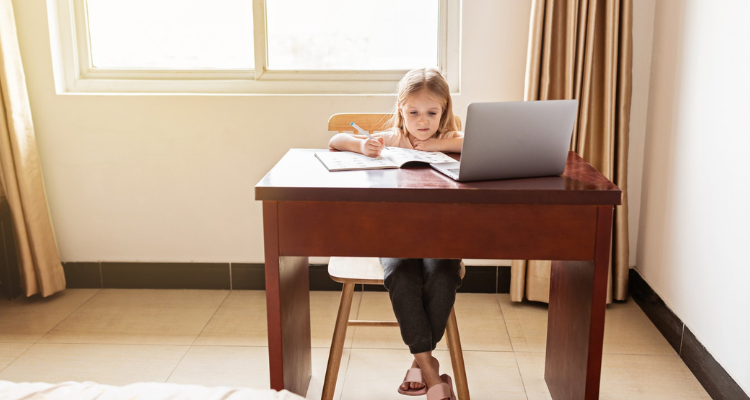
Quarantining is a completely new phenomenon to those of us who have lived through it this past year. Difficulties have arisen for everyone, and kids grapple with a unique set of challenges. However, quarantine might not be the root cause of all common problems that kids this year are facing; this unusual circumstance has brought them to the forefront.
Long before quarantine set in, mental health struggles had been surfacing in children. 20-35% of kids experience some type of body discomfort triggered by stress, and intense feelings of anxiousness and overwhelm have been on the rise in our youth population. School tends to be the main stressor for kids, along with sports, extra-curricular activities, and social pressures.[1]
For over a year, kids and adults alike have been isolated from their support systems, unable to spend time in nature and outside their regular modes of exercise and daily routines. Adding insult to injury, kids have spent far more time on electronic devices, which is known to increase feelings of anxiousness and isolation.
Suddenly, children are being thrown back into school and activities, and this can feel like an abrupt and scary transition for some. In this article, you’ll learn how to help kids transition out of quarantine and what might be a sign that they are struggling.
How to know if your child is having trouble transitioning out of quarantine
Depending on the age of the child, signs of trouble transitioning out of quarantine will vary. Young children have spent a significant percentage of their lives in quarantine, and simply leaving the house might feel stressful. Older kids who were totally submerged in school, extracurriculars, and social interaction have had their world turned upside down.

Small children might be extra clingy and whiny, acting out more frequently, refusing to sleep alone, always wanting a parent within eyesight, or worrying excessively. Physical manifestations such as occasional headaches, stomachaches, loose stools, or body discomfort might also indicate that they’re struggling. Older children are more likely to experience trouble sleeping, daytime fatigue, and withdrawal, and these factors can also impact kid's immune health.
Any issues that were present in kids prior to quarantine, such as occasional outbursts, lashing out, anger issues, musculoskeletal discomfort, headaches, stomach aches, loose stools, or trouble going to the bathroom, have likely been magnified during quarantine and have perhaps intensified while transitioning out of it.
helping your kids transition out of quarantine
There are two primary factors to consider when helping your kids transition out of quarantine. How can you support this transition, and how can you support withdrawal from over a year of excessive screen time?
Despite the real challenges of homeschooling, isolation, and juggling work with school, many families have had the opportunity to learn new ways of schooling that might actually work well for their children’s specific learning needs. Allow your older kids to partake in this discussion and answer the following questions:
- What have they enjoyed about this year?
- What new learning style might have worked well for them?
- What new opportunities arose, like hobbies or activities?
- How can we take this and incorporate them into the transition out of quarantine?
Furthermore, discussing what it means to be a healthy person in the world can help ease your children’s transition into the overwhelming stressors of school, activities, and other social pressures. Invite them to reconsider what constitutes a healthy life: whole foods, exercise, stress reduction, human connection, and creative endeavors, for example. Being a good student or athlete can fit into this process, but it isn’t the whole picture.
Calming nutrient and herb supports might be recommended by your integrative doctor, such as L-Theanine, magnesium, omega-3 fatty acids, vitamin D, and adaptogenic herbs.*
quarantine screen time withdrawal
Most kids have been spending excessive time on electronics for more than a year now and will be experiencing withdrawal. It’s widely accepted that screen time is associated with unhealthy weight, lessened social activity and family time, and poorer mental health.[2]
Addressing this requires a truly integrative approach to a problem that has been profoundly amplified during quarantine. Consider the following strategies:
Model Healthy Habits
If your kids see you constantly distracted and on your phone outside of work hours, it becomes difficult to set the standard of limited screen time. This is beneficial for parents as well, as you can take the opportunity to read books, spend quality time with your family, and enjoy more enriching activities.
Make Screen Time a Privilege
For all ages, screen time should be considered an earned privilege instead of a right. This means good behavior, chores, and homework are completed before any allotted amount of screen time.
Discourage Multitasking
We have become a society of multitaskers but to our detriment. Multitasking —especially media multitaskers— reduces productivity and negatively impacts concentration, cognitive function, and more. If your child is doing their homework or another activity, having their phone in another place and the TV turned off is key.[3]
Establish Household Rules
This will depend on your family, but make sure to establish clear rules and stick to them. For example, no screens one to two hours before bed, no screens in the bedroom, and definitely no screens or devices during meal times.
Prioritize Exercise and Time Outdoors
Always make time outdoors and physical activity a priority over screens. Get out for a family walk, play ball at the local park, or enroll your kids in a team or individual sport.
Talk About Negative Consequences
With older kids, talk openly about their electronic use and what the consequences are. They should be well aware that the research shows a significant decrease in short and long-term wellbeing with the overuse of electronics.[4]
Take a Family Day Off
Take a weekly day off from screens as a family. This might feel difficult at first, but many families have found it incredibly beneficial and a great way to bond.
not going back to school? quarantine activities for kids
If your kids aren’t yet transitioning out of quarantine, you might be desperate for some new ideas. Check out indoor activities for quarantine here, and take full advantage of summer weather to be outdoors as much as possible.
If local activities are picking up steam, consider taking advantage of opportunities that will allow your kids to ease back into social settings. If they are showing signs of occasional stress, opt for individual sports like martial arts, fencing, dance classes, or swimming, which will allow them to share with others, but maintain some personal space.
conclusion
There is no “normal” way to transition out of quarantine—this is new for everybody. Be gentle with your kids and your family, and allow the process to move slowly if need be. Invite your children to be part of the process, and spend time recognizing some positives and new ways of being that may have arisen from quarantine. And if your kids are really struggling, seek professional help.

[1] Friedrichsdorf, S. J., Giordano, J., Desai Dakoji, K., Warmuth, A., Daughtry, C., & Schulz, C. A. (2016). Chronic Pain in Children and Adolescents: Diagnosis and Treatment of Primary Pain Disorders in Head, Abdomen, Muscles and Joints. Children (Basel, Switzerland), 3(4), 42. https://doi.org/10.3390/children3040042
[2] Saunders TJ, Vallance JK. Screen Time and Health Indicators Among Children and Youth: Current Evidence, Limitations and Future Directions. Appl Health Econ Health Policy. 2017;15(3):323-331. doi:10.1007/s40258-016-0289-3
[3] Ophir E, Nass C, Wagner AD. Cognitive Control in Media Multitaskers. Proc Natl Acad Sci USA. 2009;106(37):15583-7. doi:10.1073/pnas.0903620106
[4] Dienlin, T., & Johannes, N. (2020). The impact of digital technology use on adolescent well-being. Dialogues in clinical neuroscience, 22(2), 135–142. https://doi.org/10.31887/DCNS.2020.22.2/tdienlin











.jpg)






